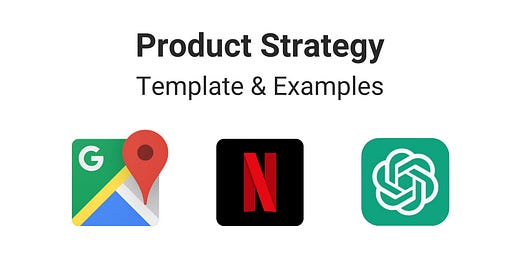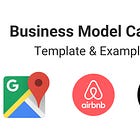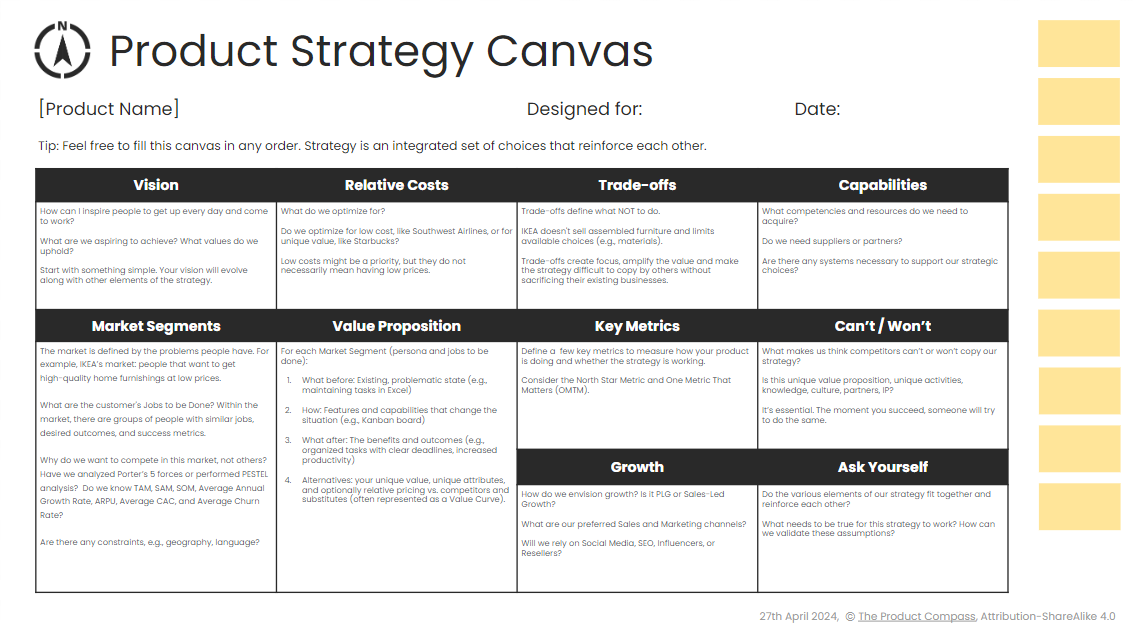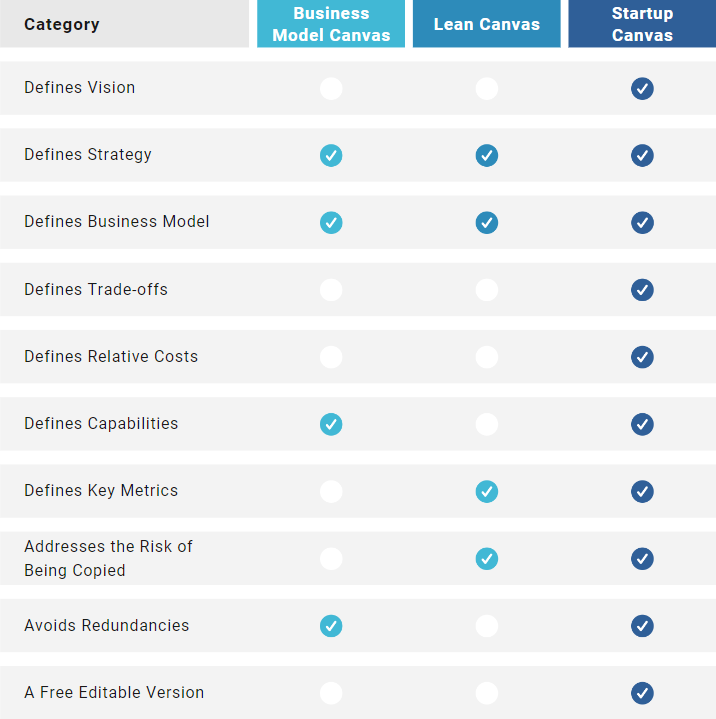Product Strategy Examples: Google Maps, Netflix, OpenAI
Editable template, case studies, and alternatives.
Hey, Paweł here. Welcome to the free edition of The Product Compass!
Every week, I share actionable tips and resources for PMs.
Here are a few posts you might have recently missed:
Introduction to AI PM: Neural Networks, Transformers, and LLMs
12 Proven Sources of Insights to Fuel Your Product Discovery
5 Steps to Negotiate Your Product Manager Job Offer in a Tough Market
Assumption Prioritization Canvas: How to Identify And Test The Right Assumptions
Consider subscribing and upgrading your account for the full experience.
I created a dedicated section of the newsletter, “Glossary and Examples,” to discuss common PM terms and frameworks with examples. Most of the posts from that area will be published on workdays, in addition to our weekly schedule.
Previously, you were not notified about the first post I’ve been testing since July:
In today’s post, we discuss examples of product strategy:
Product Strategy: Editable Template
Product Strategy: Examples
Google Maps,
Netflix,
OpenAI.
Product Strategy Canvas: Alternatives
Premium: An Editable Notion Template
Product Strategy: Editable Template
The Product Strategy Canvas combines strategic elements to help you define and communicate your product strategy.
You can learn more and get a free editable template by reading this free post.
Product Strategy Examples
Example 1: Product Strategy for Google Maps
1. Vision
Organize the world's geographical information and make it universally accessible and useful for everyone.
2. Market Segments
Individuals who need reliable navigation and local information.
Businesses that need mapping services for logistics and customer engagement.
Developers who need geospatial APIs to enhance their products.
3. Relative Costs
Optimizing for unique value rather than competing on cost.
4. Value Proposition
For individuals needing reliable navigation and local information:
Before: People relied on paper maps or basic GPS devices, leading to inaccurate directions and difficulty finding local services.
How: Google Maps provides real-time navigation, traffic updates, public transit information, and detailed local business data accessible on multiple devices.
After: Users enjoy accurate, efficient navigation and can easily discover and engage with local businesses and services.
Alternatives: Differentiated by global coverage, real-time data, Street View, and integration with other Google services like Google Search and Google Assistant.
5. Trade-offs
No Dedicated Hardware: Focus solely on software solutions.
Data Collection for Services: Collect user data to improve services, raising privacy considerations.
No User Fees: Monetize via advertising and enterprise offerings rather than direct user fees.
6. Key Metrics
Daily Active Users (DAU): The number of unique daily users.
Session Duration: The average time spent per session to assess user engagement.
Data Accuracy: The accuracy of mapping data by monitoring error reports and resolution times.
User-Generated Content: The volume and quality of user contributions like reviews, photos, and map edits.
7. Growth
User-Generated Content: Encourage users to add reviews, photos, and local insights through programs like Local Guides.
Expanding into Local Markets: Localize content and features to meet regional needs and preferences.
Partnerships with Businesses: Collaborate with local businesses to enhance listings and provide detailed information.
Integration with the Google Ecosystem: Leverage other Google services (e.g., Search, Google Assistant) to drive user engagement.
8. Capabilities
Advanced Data Collection: Utilize data from 1,000+ authoritative sources for comprehensive mapping.
Machine Learning and AI: Leverage AI to improve navigation, predict traffic, and improve the user experience.
Global Partnerships: Partner with governments, transit agencies, and businesses worldwide to improve data quality.
9. Can't / Won't
Competitors can't easily replicate Google Maps' extensive mapping data, real-time updates, user-generated contributions, and integration within the Google ecosystem without significant investment and technological development.
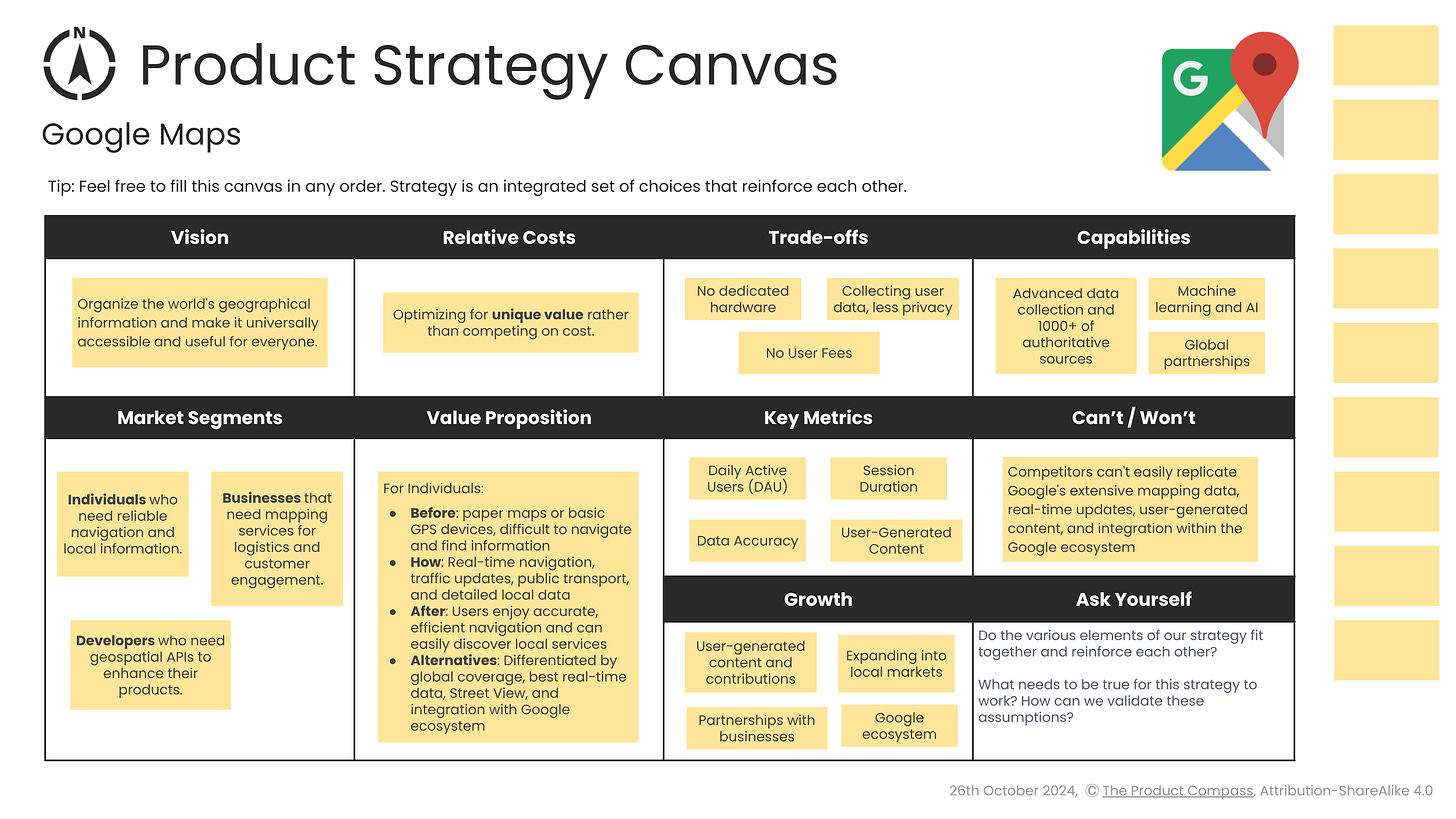
Example 2: Product Strategy for Netflix
1. Vision
Entertain the world by providing the best streaming entertainment service.
2. Market Segments
Individuals who need on-demand, ad-free entertainment across various genres.
Regional viewers who desire localized and diverse content tailored to their preferences.
Families looking for shared entertainment options suitable for all ages.
3. Relative Costs
Optimizing for unique value through exclusive and original content rather than competing on the lowest subscription price.
4. Value Proposition
For individuals with ad-free plans:
Before: Audiences were limited to scheduled TV programming with advertisements and had restricted access to diverse content.
How: A vast library of movies, TV shows, and original productions available anytime and without ads on multiple devices.
After: Users enjoy a personalized, uninterrupted viewing experience adjusted to their preferences.
Alternatives: Differentiated by original productions, user-friendly interface, and recommendation algorithms.
5. Trade-offs
No Live TV Broadcasts: Does not offer live sports or news.
No Free Tier: Avoids an ad-supported free option to maintain a premium user experience.
No User-Generated Content: Avoids user-generated content to ensure quality control.
6. Key Metrics
Subscriber Growth Rate: The monthly or quarterly percentage increase in global paid subscribers (e.g., 10% quarterly growth).
Churn Rate: The percentage of subscribers canceling their subscription each month, aiming to keep it below a specific threshold (e.g., under 2% monthly).
Average Viewing Hours per User: Calculate the average number of hours streamed per user weekly to assess engagement (e.g., aiming for 10 hours/week).
7. Growth
Original Content Production: Invest in diverse, high-quality original productions to attract new subscribers.
Market Expansion: Expand into new international markets with localized content.
Enhanced Personalization: Use machine learning to personalize user experiences.
8. Capabilities
Content Production and Acquisition: Creating and acquiring compelling original content.
Streaming Infrastructure: Technology for reliable, high-quality streaming.
Machine Learning: Use machine learning to provide personalized content recommendations.
9. Can't / Won't
Competitors cannot easily match Netflix's scale of original content production and advanced recommendation system. Many productions are available only on Netflix, making them impossible to copy.
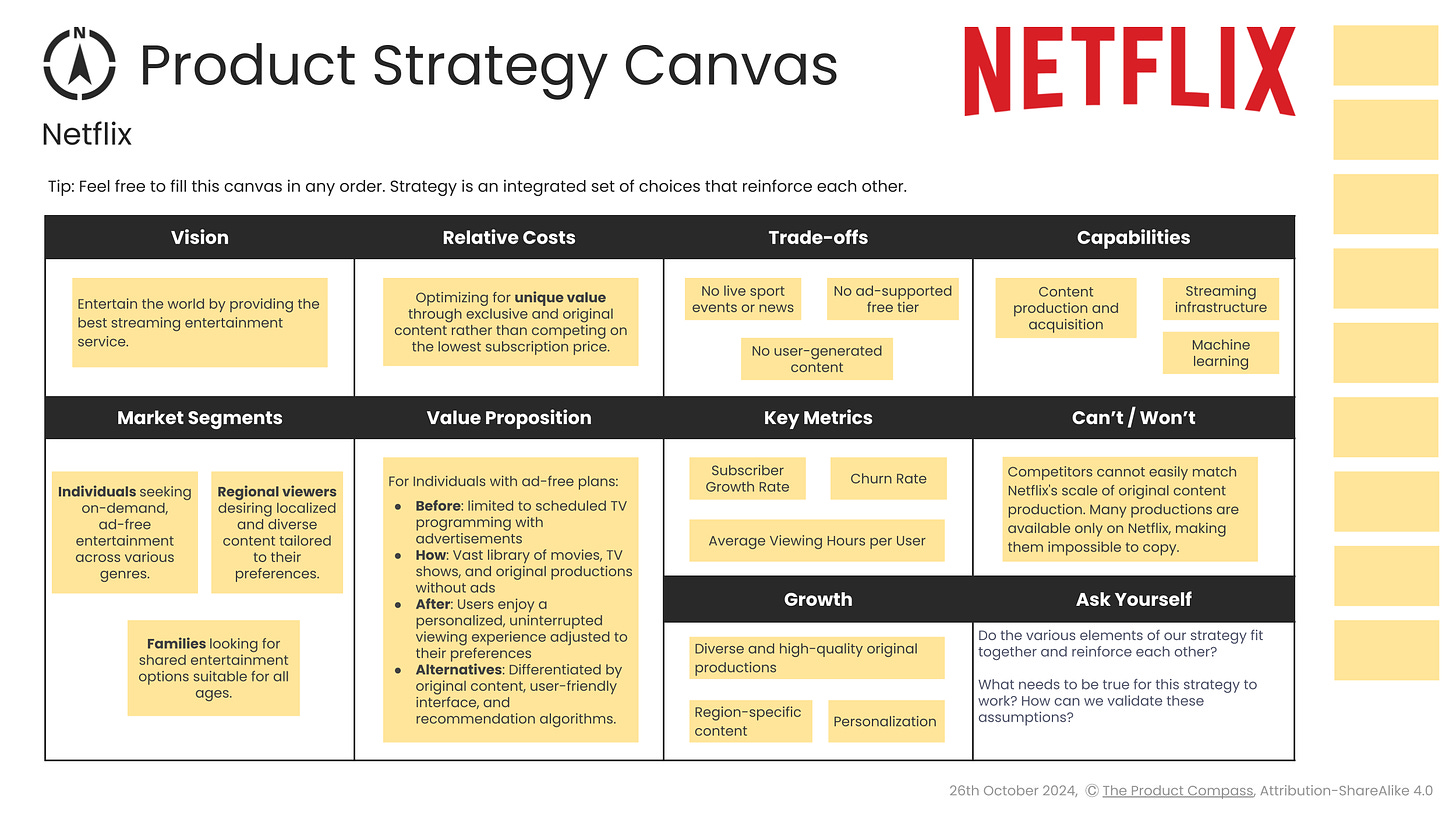
Example 3: Product Strategy for OpenAI
1. Vision
Ensure that artificial general intelligence (AGI) benefits all of humanity by advancing AI technology responsibly.
2. Market Segments
Individuals who need AI-powered assistance for learning, productivity, and entertainment.
Developers who need advanced AI tools, APIs, and models.
Businesses that need AI solutions to improve operations and services.
3. Relative Costs
Compete on performance-to-cost ratio with smaller models while maintaining unique value (the best benchmarks) for top-tier performance.
4. Value Proposition
For individuals who need AI-powered assistance:
Before: Limited access to advanced AI due to high costs and technical barriers.
How: Accessible applications (e.g., ChatGPT) with affordable subscriptions.
After: Enhanced productivity, learning, and entertainment through intuitive, easy-to-use AI.
Alternatives: Differentiated by superior AI capabilities, partnerships, constant innovation, and ethical commitment.
5. Trade-offs
No Open-Source: Advanced models remain proprietary.
No Custom Solutions: Focus on versatile, general-purpose AI rather than niche customization.
No Hardware Development: Rely on partners for infrastructure needs instead of developing custom hardware.
6. Key Metrics
Monthly Revenue: Monthly revenue from subscriptions and usage-based fees.
Monthly Active Users (MAU): User engagement across different platforms.
AI Benchmarks: Maintain top-tier performance in industry-standard datasets, ensuring a competitive performance-to-cost ratio.
Policy Compliance Rate: Ensure compliance with safety guidelines.
7. Growth
Innovation: Continuous R&D to improve AI models and cut costs.
Strategic Partnerships: Leverage collaborations (e.g., with Microsoft) for resources and integration into widely-used platforms.
Funding Initiatives: Seek additional investments to support growth and transition to a sustainable for-profit model.
8. Capabilities
AI R&D: World-class research and development capabilities.
Strategic Partnerships: Strong partnerships for technological and market reach.
Infrastructure: Scalable systems for training and deploying large-scale AI models.
Ethics & Safety: Dedicated teams to ensure ethical and safe AI.
9. Can't / Won't
Competitors can't easily replicate OpenAI's combination of advanced AI technology, strategic partnerships — especially with Microsoft's enterprise reach — and commitment to ethical AI without significant investment and expertise.
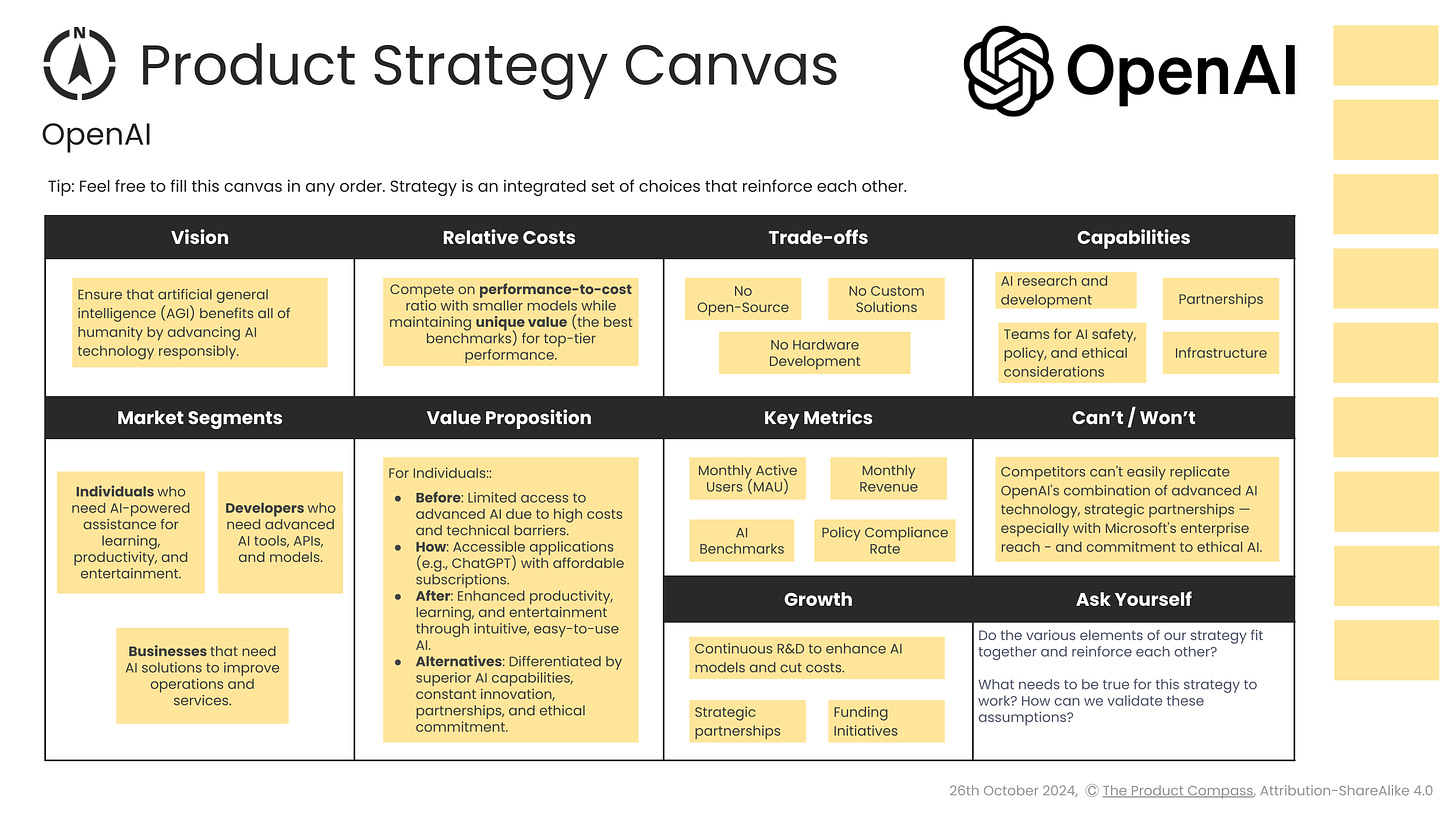
Product Strategy Canvas: Alternatives
Product Strategy Canvas is not the only available tool. Depending on what you are looking for, you might also consider:
For a new product:
Startup Canvas (Product Strategy and a Business Model for a new product)
Lean Canvas (File > Download)
For an existing product, a better choice would be Product Strategy Canvas.
Premium: An Editable Notion Template
My premium subscribers can access a Notion template that they can easily duplicate to their Notion account.
Our premium PM resources: https://www.productcompass.pm/p/your-premium-pm-resources
Thanks for reading The Product Compass!
It's great to learn and grow together with you.
Have a fantastic weekend and a productive week ahead,
Paweł

